Study on the Compatibility of SBR and Asphalt Base Based on Molecular Simulation
Abstract
1. Introduction
1.1. Construction of Molecular Models
1.1.1. Asphalt
1.1.2. SBR Modifier
1.2. Building a Crystal Cell Model
1.3. Molecular Model Optimization and Kinetic Operations
1.4. Validation of Molecular Models
2. Compatibility Study of SBR with Asphalt Based on Molecular Simulation
2.1. Solubility Parameters
2.1.1. Simulation Methods
2.1.2. Principle of Solubility Parameter Calculation
2.1.3. Results and Discussion
2.2. Interaction Energy
2.2.1. Principle of Interaction Energy
2.2.2. Simulation Methods
2.2.3. Results and Discussion
3. SBR and Asphalt Compatibility Test Verification
3.1. Preparation of SBR-Modified Asphalt
3.2. Microscopic Morphology Analysis of Modified Asphalt
3.3. Dynamic Shear Rheology Based Compatibility Testing
4. Conclusions
- (1)
- Through the examination of the SBR-modified asphalt blending model, it was discovered that at 160 °C, the solubility parameter difference between the SBR modifier and matrix asphalt was minimal, and the interaction was at its strongest, indicating optimal compatibility. The interactions within the SBR-modified asphalt blending systems were primarily governed by van der Waals forces, and the addition of SBR improved the organization of the asphalt molecules.
- (2)
- The SEM test outcomes revealed that the compatibility interface between SBR and asphalt was the most stable at 160 °C. Additionally, based on the Cole–Cole plot, the rheological properties of the modified asphalt prepared at this temperature were deemed to be superior.
Author Contributions
Funding
Institutional Review Board Statement
Informed Consent Statement
Data Availability Statement
Conflicts of Interest
References
- Al-Hadidy, A.I.; Yi-qiu, T. Effect of styrene-butadiene-styrene on the properties of asphalt and stone-matrix-asphalt mixture. J. Mater. Civ. Eng. 2011, 23, 504–510. [Google Scholar] [CrossRef]
- Hemmati, N.; Yun, J.; Mazumder, M.; Lee, M.S.; Lee, S.J. Laboratory Characterization of Asphalt Binders Modified with Styrene Butadiene Rubber (SBR). Materials 2021, 14, 7666. [Google Scholar] [CrossRef]
- Han, Y.; Cui, B.; Tian, J.; Ding, J.; Ni, F.; Lu, D. Evaluating the effects of styrene-butadiene rubber (SBR) and polyphosphoric acid (PPA) on asphalt adhesion performance. Constr. Build. Mater. 2022, 321, 126028. [Google Scholar] [CrossRef]
- Yao, H.; Liu, J.; Xu, M.; Ji, J.; Dai, Q.; You, Z. Discussion on molecular dynamics (MD) simulations of the asphalt materials. Adv. Colloid Interface Sci. 2022, 299, 102565. [Google Scholar] [CrossRef] [PubMed]
- Xie, T.; He, Z.; Yu, H.; Ma, Y.; Shi, C.; Zhang, C.; Dai, W. Evaluation of styrene butadiene rubber asphalt modification mechanism and adhesion effect based on molecular simulation. Fuel 2024, 364, 131023. [Google Scholar] [CrossRef]
- Gao, M.; Fan, C.; Chen, X.; Li, M. Study on ultraviolet aging performance of composite modified asphalt based on rheological properties and molecular dynamics simulation. Adv. Mater. Sci. Eng. 2022, 2022, 7894190. [Google Scholar] [CrossRef]
- Samieadel, A.; Oldham, D.; Fini, E.H. Multi-scale characterization of the effect of wax on intermolecular interactions in asphalt binder. Constr. Build. Mater. 2017, 157, 1163–1172. [Google Scholar] [CrossRef]
- Guo, F.; Zhang, J.; Pei, J.; Ma, W.; Hu, Z.; Guan, Y. Evaluation of the compatibility between rubber and asphalt based on molecular dynamics simulation. Front. Struct. Civ. Eng. 2020, 14, 435–445. [Google Scholar] [CrossRef]
- Yu, X.; Wang, J.; Si, J.; Mei, J.; Ding, G.; Li, J. Research on compatibility mechanism of biobased cold-mixed epoxy asphalt binder. Constr. Build. Mater. 2020, 250, 118868. [Google Scholar] [CrossRef]
- Bhasin, A.; Bommavaram, R.; Greenfield, M.L.; Little, D.N. Use of molecular dynamics to investigate self-healing mechanisms in asphalt binders. J. Mater. Civ. Eng. 2011, 23, 485–492. [Google Scholar] [CrossRef]
- Ding, Y.; Huang, B.; Shu, X.; Zhang, Y.; Woods, M.E. Use of molecular dynamics to investigate diffusion between virgin and aged asphalt binders. Fuel 2016, 174, 267–273. [Google Scholar] [CrossRef]
- Polacco, G.; Filippi, S.; Merusi, F.; Stastna, G. A review of the fundamentals of polymer-modified asphalts: Asphalt/polymer interactions and principles of compatibility. Adv. Colloid Interface Sci. 2015, 224, 72–112. [Google Scholar] [CrossRef] [PubMed]
- Li, X.; Wang, Y.M.; Wu, Y.L.; Wang, H.R.; Chen, M.; Sun, H.D.; Fan, L. Properties and modification mechanism of asphalt with graphene as modifier. Constr. Build. Mater. 2021, 272, 121919. [Google Scholar] [CrossRef]
- Porto, M.; Caputo, P.; Loise, V.; Eskandarsefat, S.; Teltayev, B.; Oliviero Rossi, C. Bitumen and bitumen modification: A review on latest advances. Appl. Sci. 2019, 9, 742. [Google Scholar] [CrossRef]
- Emtiaz, M.; Imtiyaz, M.N.; Majumder, M.; Idris, I.I.; Mazumder, R.; Rahaman, M.M. A Comprehensive Literature Review on Polymer-Modified Asphalt Binder. Civil Eng. 2023, 4, 901–932. [Google Scholar] [CrossRef]
- Behnood, A.; Gharehveran, M.M. Morphology, rheology, and physical properties of polymer-modified asphalt binders. Eur. Polym. J. 2019, 112, 766–791. [Google Scholar] [CrossRef]
- Jitsangiam, P.; Nusit, K.; Phenrat, T.; Kumlai, S.; Pra-ai, S. An examination of natural rubber modified asphalt: Effects of rubber latex contents based on macro-and micro-observation analyses. Constr. Build. Mater. 2021, 289, 123158. [Google Scholar] [CrossRef]
- Singh, B.; Saboo, N.; Kumar, P. Use of Fourier transform infrared spectroscopy to study ageing characteristics of asphalt binders. Pet. Sci. Technol. 2017, 35, 1648–1654. [Google Scholar] [CrossRef]
- Saboo, N.; Sukhija, M. Evaluating the suitability of nanoclay-modified asphalt binders from 10 °C to 70 °C. J. Mater. Civ. Eng. 2020, 32, 04020393. [Google Scholar] [CrossRef]
- Chu, L.; Luo, L.; Fwa, T.F. Effects of aggregate mineral surface anisotropy on asphalt-aggregate interfacial bonding using molecular dynamics (MD) simulation. Constr. Build. Mater. 2019, 225, 1–12. [Google Scholar] [CrossRef]
- Li, D.D.; Greenfield, M.L. Chemical compositions of improved model asphalt systems for molecular simulations. Fuel 2014, 115, 347–356. [Google Scholar] [CrossRef]
- Guthrie, W.S.; Brown, A.V.; Eggett, D.L. Cement stabilization of aggregate base material blended with reclaimed asphalt pavement. Transp. Res. Rec. 2007, 2026, 47–53. [Google Scholar] [CrossRef]
- Surya, I.; Ismail, H. Effects of alkanolamide addition on cure characteristics, crosslink density and tensile properties of carbon-black-filled styrene-butadiene rubber compounds. MATEC Web of Conf. 2018, 197, 12006. [Google Scholar] [CrossRef][Green Version]
- Bhamare, V.G.; Joshi, R.R.; Gangurde, M.S.; Pawar, V.V. Theoretical consideration of solubility by Hildebrand solubility approach. World J. Adv. Res. Rev. 2021, 12, 528–541. [Google Scholar] [CrossRef]
- Binder, K.; Horbach, J.; Kob, W.; Paul, W.; Varnik, F. Molecular dynamics simulations. J. Phys. Condens. Matter 2004, 16, S429. [Google Scholar] [CrossRef]
- Vijayalakshmi, R.; Agawane, N.T.; Talawar, M.B.; Khan, M.A.S. Examining the compatibility of energetic plasticizer DNDA-5 with energetic binders. J. Macromol. Sci. Part A 2020, 57, 46–54. [Google Scholar] [CrossRef]
- Powles, J.G. Cole-Cole plots as they should be. J. Mol. Liq. 1993, 56, 35–47. [Google Scholar] [CrossRef]
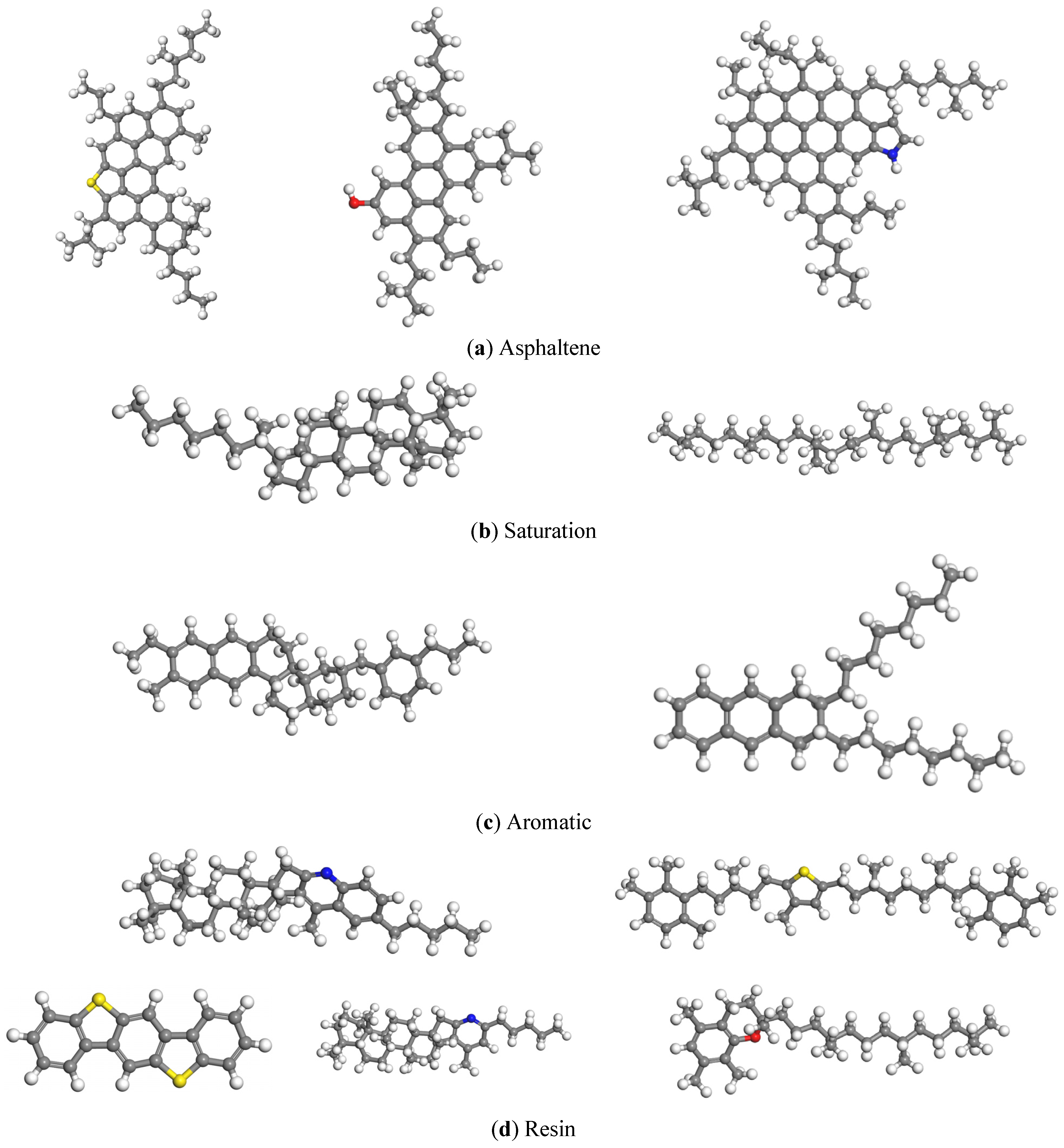

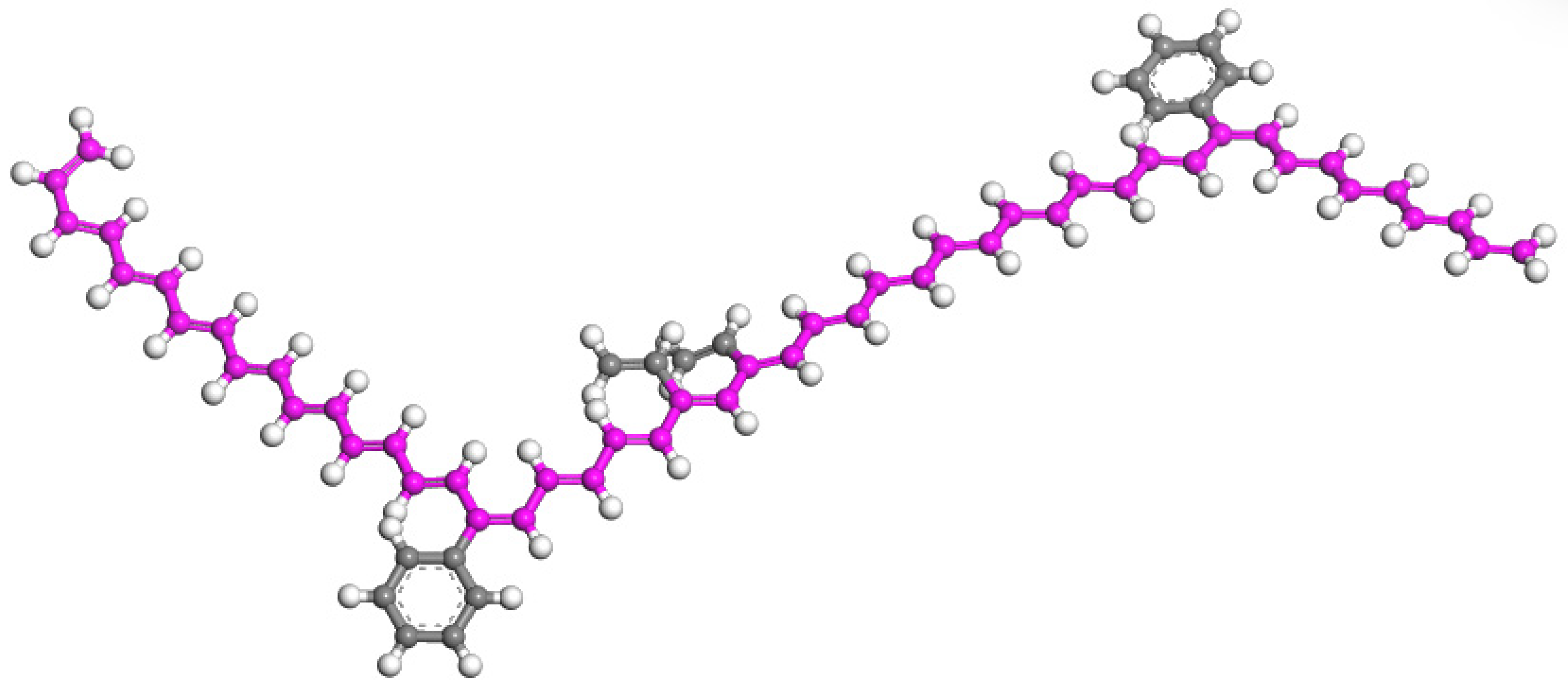
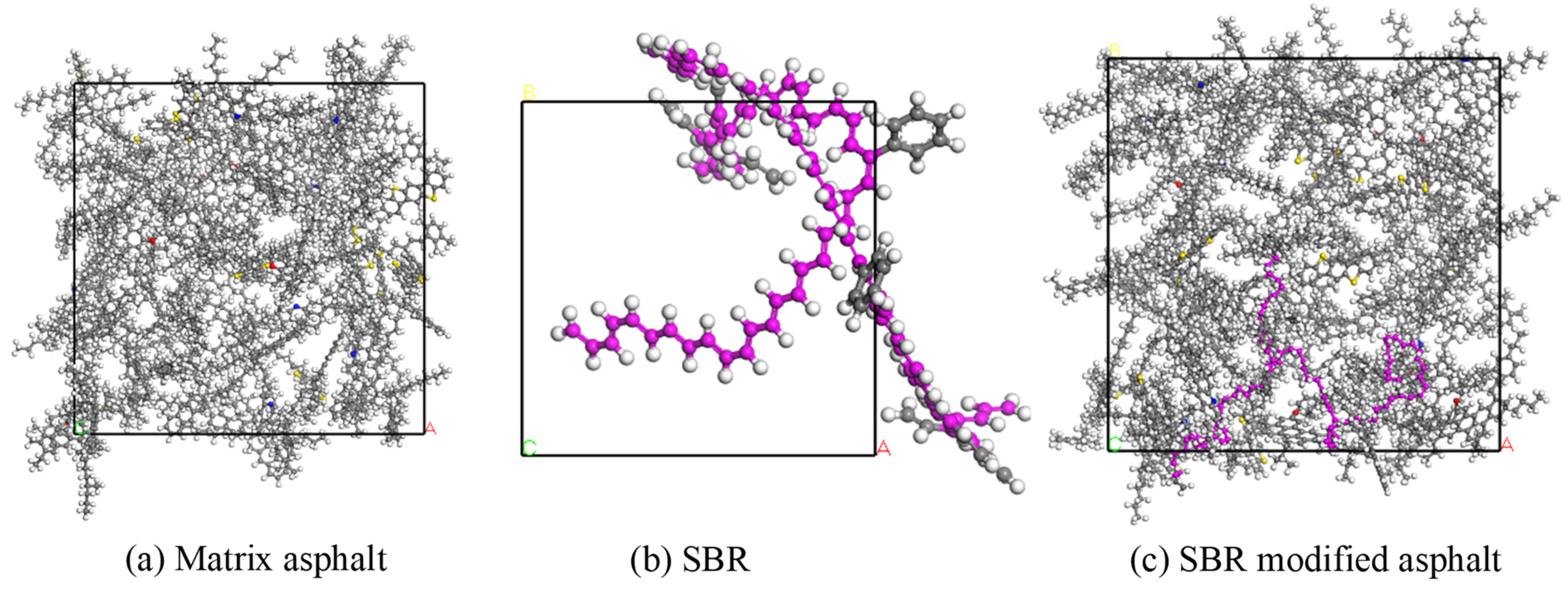
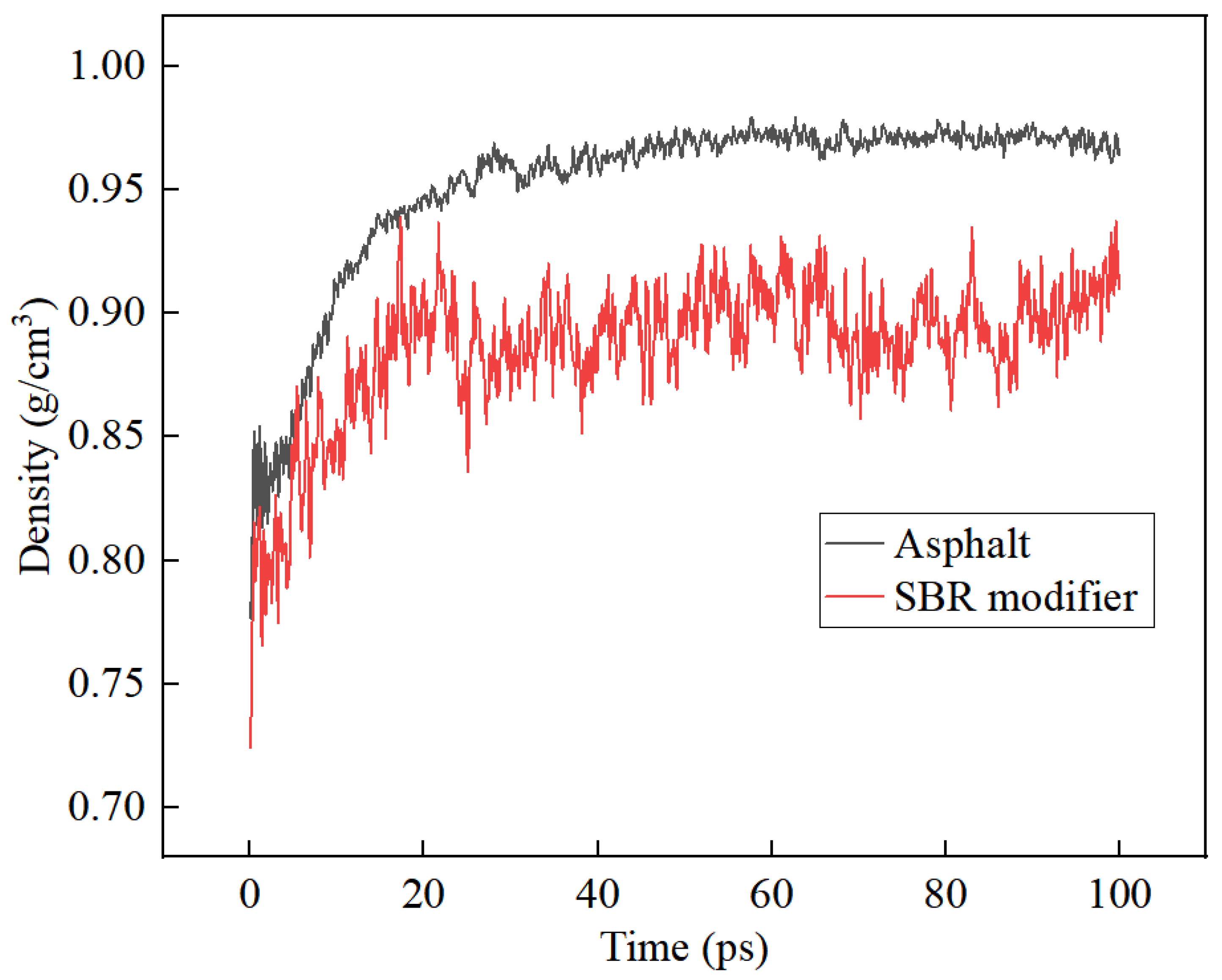
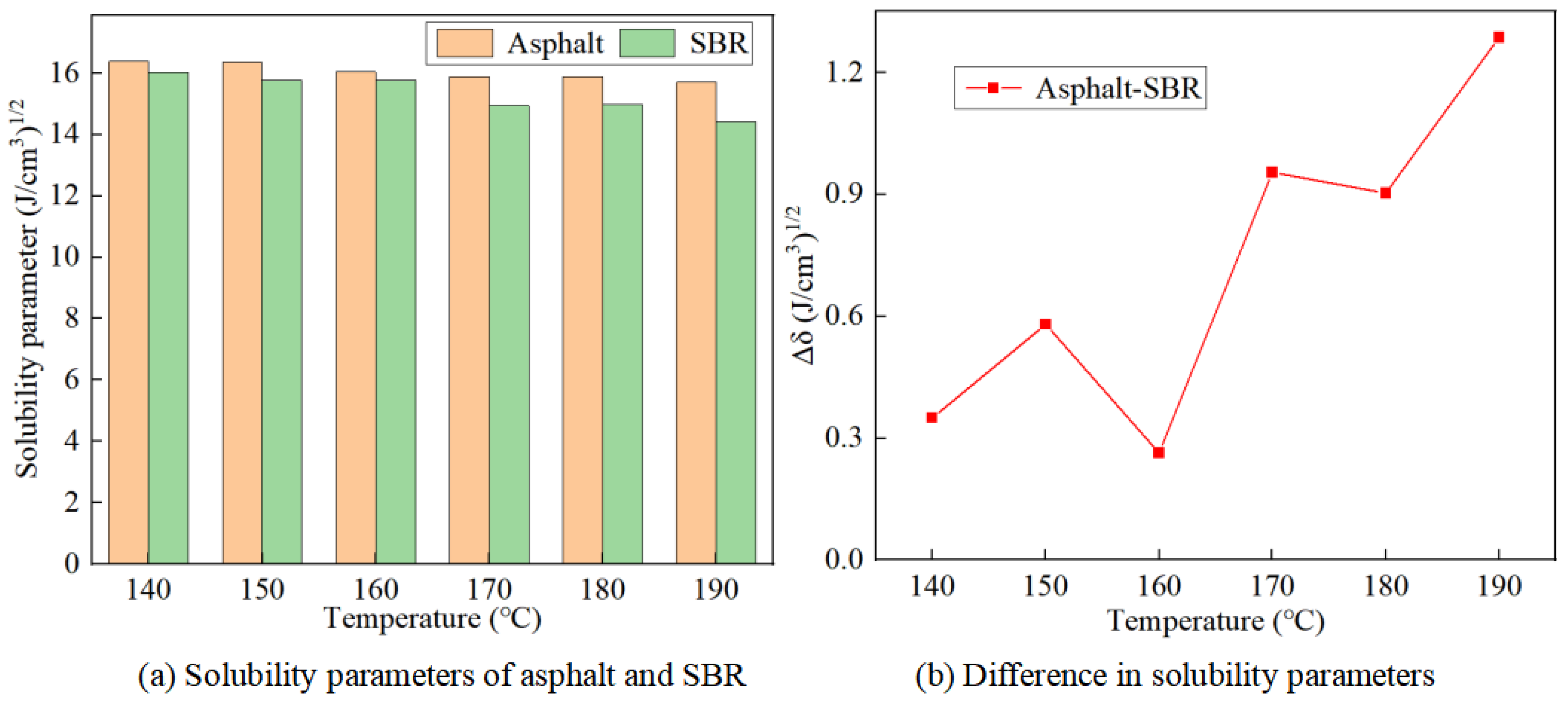

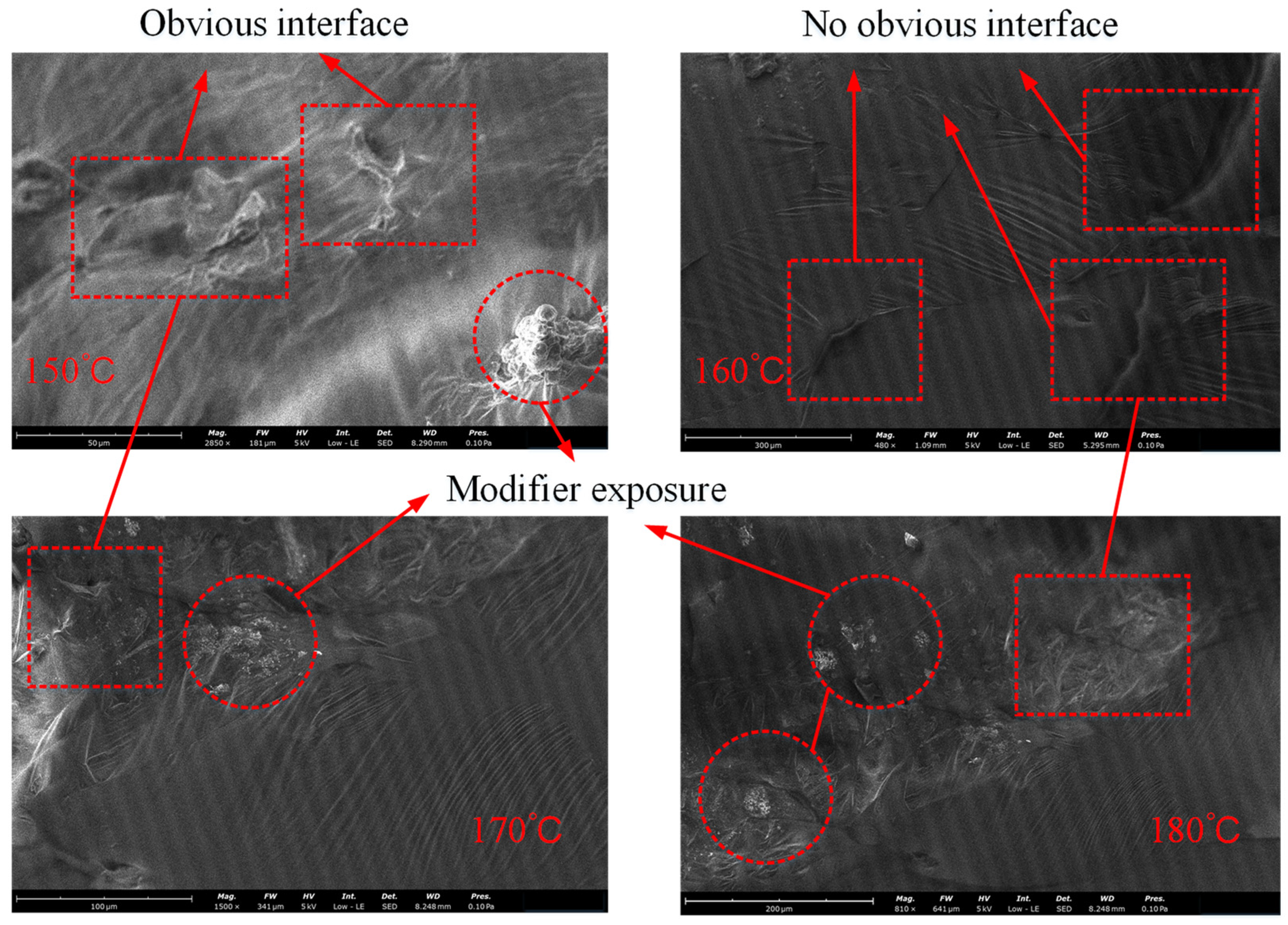
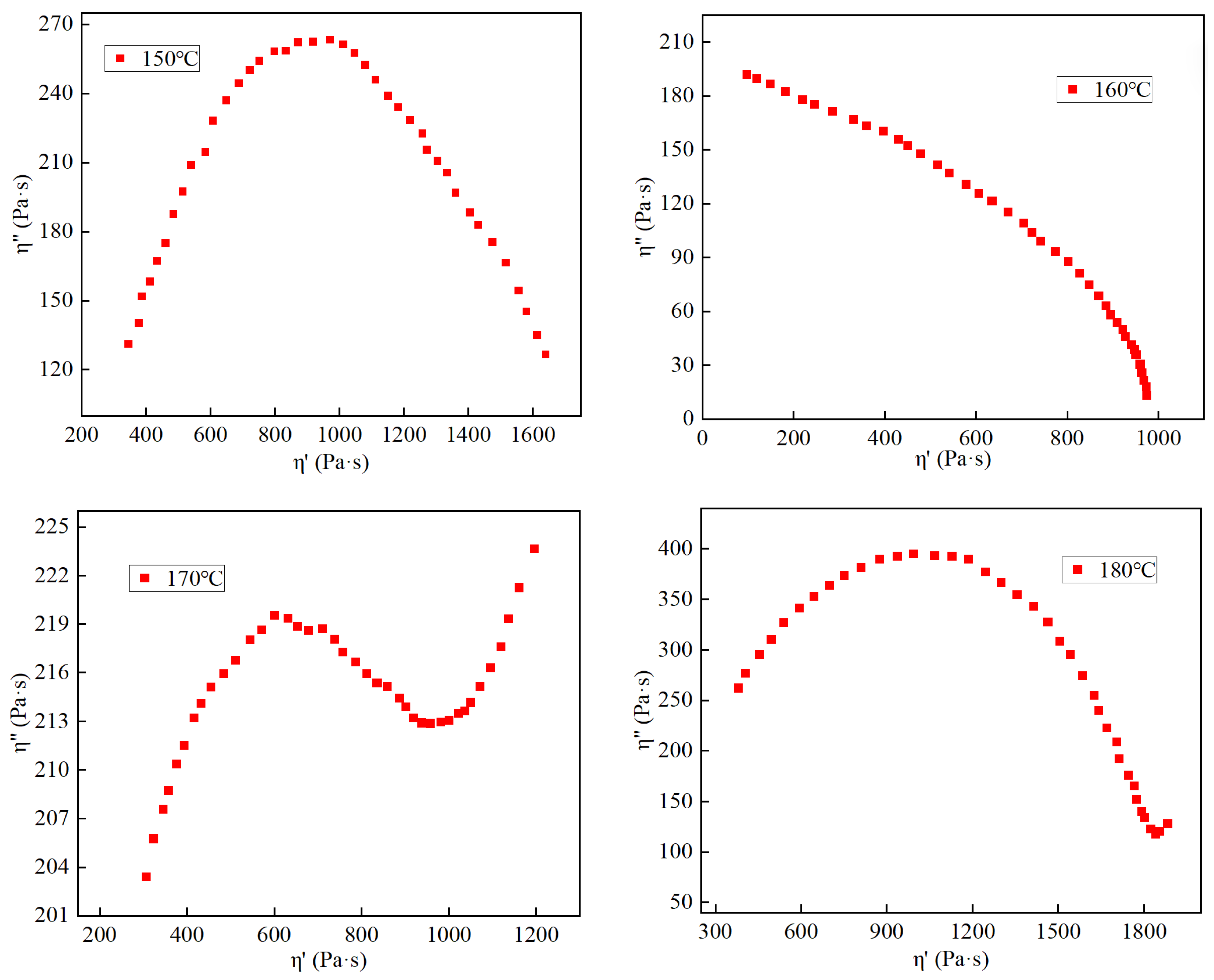
| Components | Molecular Formula | Molecular Number | Percentage of Components (%) |
|---|---|---|---|
| Asphaltene | C51H62S | 2 | 10.35 |
| C42H54O | 2 | ||
| C66H81N | 1 | ||
| Saturation | C35H62 | 4 | 10.86 |
| C30H62 | 4 | ||
| Aromatic | C30H46 | 21 | 50.68 |
| C35H44 | 18 | ||
| Resin | C18H10S2 | 8 | 28.11 |
| C36H57N | 4 | ||
| C29H50O | 4 | ||
| C40H60S | 3 | ||
| C40H59N | 3 |
| Component | Mass Ratio | Molecular Weight | Number of Molecules |
|---|---|---|---|
| Styrene | 14.8% | 106 g/mol | 2 |
| Trans butadiene | 62.6% | 56 g/mol | 9 |
| Cis butadiene | 7.8% | 56 g/mol | 1 |
| 1.2 Butadiene | 14.8% | 56 g/mol | 2 |
| Temperature (°C) | 140 | 150 | 160 | 170 | 180 | 190 | |
|---|---|---|---|---|---|---|---|
| SBR-modified asphalt | Ep | 45,548.37 | 45,851.15 | 46,775.12 | 47,576.17 | 49,158.31 | 49,519.14 |
| Ev | −2591.69 | −2509.28 | −2432.36 | −2253.12 | −2248.35 | −2118.20 | |
| Ee | −3756.62 | −3778.64 | −3778.18 | −3745.41 | −3755.66 | −3774.83 | |
| Matrix asphalt | Ep | 45,360.09 | 45,780.30 | 46,767.42 | 47,414.54 | 49,007.48 | 49,390.74 |
| Ev | −1807.38 | −1732.21 | −1522.42 | −1474.92 | −1438.47 | −1292.54 | |
| Ee | −3744.91 | −3776.96 | −3758.88 | −3736.16 | −3747.79 | −3766.37 | |
| SBR | Ep | 969.37 | 1023.99 | 1098.60 | 1147.11 | 1158.53 | 1165.19 |
| Ev | 119.77 | 131.91 | 137.73 | 146.39 | 159.45 | 171.38 | |
| Ee | −9.17 | −2.72 | −14.27 | −5.40 | −7.20 | −6.36 | |
| Technical Indicators | Density (g/cm3) | Penetration at 25 °C (0.1 mm) | Ductility at 15 °C (mm) | Softening Point (°C) | Flash Point (°C) |
|---|---|---|---|---|---|
| Numerical value | 1.000 | 68 | >100 | 49.1 | >220 |
| Density (g/cm3) | Constant Tensile Strength (100%) | Tearing Strength | Friction | Hardness | S/B | Copolymer Type |
|---|---|---|---|---|---|---|
| 0.94 | 6.0 MPa | 15.1 MPa | 0.46 | 77 | 0.3–0.35 | Random copolymer |
Disclaimer/Publisher’s Note: The statements, opinions and data contained in all publications are solely those of the individual author(s) and contributor(s) and not of MDPI and/or the editor(s). MDPI and/or the editor(s) disclaim responsibility for any injury to people or property resulting from any ideas, methods, instructions or products referred to in the content. |
© 2024 by the authors. Licensee MDPI, Basel, Switzerland. This article is an open access article distributed under the terms and conditions of the Creative Commons Attribution (CC BY) license (https://creativecommons.org/licenses/by/4.0/).
Share and Cite
Jiao, X.; Huang, D.; Zhao, S.; Ouyang, J. Study on the Compatibility of SBR and Asphalt Base Based on Molecular Simulation. Materials 2024, 17, 1175. https://doi.org/10.3390/ma17051175
Jiao X, Huang D, Zhao S, Ouyang J. Study on the Compatibility of SBR and Asphalt Base Based on Molecular Simulation. Materials. 2024; 17(5):1175. https://doi.org/10.3390/ma17051175
Chicago/Turabian StyleJiao, Xiaolei, Dandan Huang, Song Zhao, and Jian Ouyang. 2024. "Study on the Compatibility of SBR and Asphalt Base Based on Molecular Simulation" Materials 17, no. 5: 1175. https://doi.org/10.3390/ma17051175
APA StyleJiao, X., Huang, D., Zhao, S., & Ouyang, J. (2024). Study on the Compatibility of SBR and Asphalt Base Based on Molecular Simulation. Materials, 17(5), 1175. https://doi.org/10.3390/ma17051175





